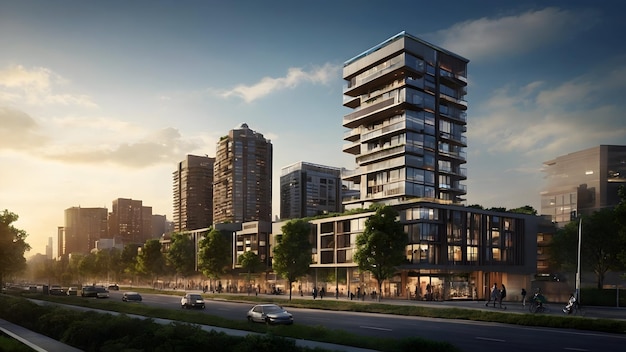Embarking on a journey through the realm of Affordable wellness solutions for urban living, readers are invited to delve into a world where well-being meets city life in harmonious balance.
Delve deeper into the challenges, strategies, and community initiatives that shape the landscape of accessible wellness options in urban settings.

Definition of Affordable Wellness Solutions for Urban Living
Affordable wellness solutions for urban living refer to accessible and cost-effective ways for city dwellers to prioritize their physical, mental, and emotional well-being amidst the hustle and bustle of urban life.
It is essential to have affordable wellness options in urban areas to ensure that individuals can maintain a healthy lifestyle despite the challenges posed by city living. Access to these solutions can help mitigate the negative effects of stress, pollution, sedentary lifestyles, and other urban-related health concerns.
Examples of Common Affordable Wellness Solutions Suitable for City Dwellers
- Outdoor Exercise: Utilizing public parks, walking or biking trails, and outdoor fitness classes can provide city residents with a cost-effective way to stay active and improve their physical health.
- Community Wellness Programs: Many urban areas offer community-based wellness programs such as yoga classes, meditation sessions, and group fitness activities at a reduced cost or even for free, making it easier for individuals to prioritize their well-being.
- Healthy Food Options: Access to affordable fresh produce markets, community gardens, and healthy food initiatives can help urban residents maintain a nutritious diet despite the challenges of food deserts and fast-food dominance in cities.
- Mental Health Resources: Affordable counseling services, support groups, and mindfulness workshops can provide city dwellers with the tools to manage stress, anxiety, and other mental health issues that are prevalent in urban environments.
Challenges of Achieving Wellness in Urban Environments
Urban living presents unique challenges that can hinder residents' ability to maintain overall wellness. Factors such as pollution, noise, and limited green spaces have a significant impact on physical and mental well-being.
Impact of Pollution on Wellness
Pollution in urban areas, whether it be air pollution from vehicles or industrial sources, can have detrimental effects on respiratory health and overall well-being. Constant exposure to pollutants can lead to respiratory diseases, allergies, and other health issues.
Effects of Noise Pollution
The constant noise in urban environments, such as traffic, construction, and crowded spaces, can increase stress levels and disrupt sleep patterns. Chronic exposure to noise pollution has been linked to various health problems, including cardiovascular issues and mental health disorders.
Importance of Green Spaces
Limited access to green spaces in cities can impact wellness by reducing opportunities for physical activity, relaxation, and stress relief. Green spaces are essential for promoting mental health, improving mood, and enhancing overall well-being
.
Psychological Effects of Urban Living
The fast-paced and competitive nature of urban life can contribute to high levels of stress, anxiety, and depression among residents. The constant pressure to succeed, coupled with social isolation and lack of community connection, can negatively impact mental health and overall wellness.
Strategies for Implementing Affordable Wellness Solutions in Urban Settings
In urban environments, it can be challenging to prioritize wellness due to busy lifestyles and limited access to affordable resources. However, there are practical ways individuals can incorporate wellness practices into their urban lifestyle.
Role of Technology in Providing Affordable Wellness Solutions
Technology plays a significant role in providing affordable wellness solutions for city dwellers. Mobile apps, fitness trackers, and online resources offer accessible ways to track health metrics, access workout routines, and connect with virtual wellness communities.
Tips on Creating a Wellness-Friendly Environment within Urban Living Spaces
- Incorporate plants and greenery into your living space to improve air quality and create a calming environment.
- Dedicate a corner for meditation or yoga practice to promote mental well-being.
- Opt for multi-functional furniture to maximize space and encourage physical activity.
- Utilize natural light by keeping windows clear and using light-colored decor to enhance mood and productivity.
Community Initiatives and Programs Promoting Affordable Wellness in Urban Areas
Community-driven wellness programs in urban settings play a crucial role in promoting affordable wellness and improving the overall health of residents. These initiatives focus on providing accessible resources, support, and education to help urban populations lead healthier lifestyles.
Examples of Community-driven Wellness Programs
- Healthy Cooking Classes: Many urban communities offer cooking classes that teach residents how to prepare nutritious meals on a budget, promoting healthier eating habits.
- Community Gardens: Urban gardens provide opportunities for residents to grow their own fruits and vegetables, increasing access to fresh produce and promoting physical activity.
- Walking and Cycling Groups: Group activities like walking and cycling clubs encourage physical exercise and social interaction, contributing to improved mental and physical well-being.
Impact of Social Support Networks on Enhancing Wellness
Social support networks within urban communities play a significant role in enhancing wellness by providing emotional encouragement, motivation, and a sense of belonging. These networks help individuals stay accountable to their wellness goals and foster a supportive environment for healthy behaviors.
Collaborative Efforts for Accessible Wellness Solutions
Collaborative efforts between local government, non-profit organizations, businesses, and community members can make wellness solutions more accessible and affordable for urban residents. By pooling resources, sharing knowledge, and working together towards common goals, these partnerships can address various wellness challenges in urban areas effectively.
Final Summary
In conclusion, the panorama of Affordable wellness solutions for urban living offers a mosaic of possibilities for city dwellers to embrace health and vitality amidst the hustle and bustle of urban life.
General Inquiries
What are some examples of affordable wellness solutions for urban living?
Common examples include community fitness classes, urban gardens, and affordable healthy meal delivery services.
How can individuals incorporate wellness practices into their urban lifestyle?
Individuals can integrate wellness by walking or biking to work, participating in outdoor yoga classes, and creating a calming space at home.
What role does technology play in providing affordable wellness solutions for city dwellers?
Technology facilitates access to virtual fitness classes, wellness apps for meditation and exercise, and online support communities for urban residents.









